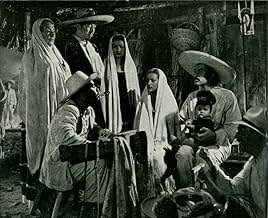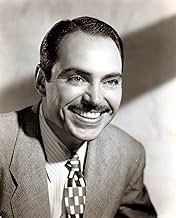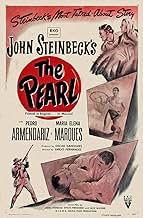CALIFICACIÓN DE IMDb
7.4/10
1.2 k
TU CALIFICACIÓN
El descubrimiento de una perla perfecta cambia para siempre la vida de un pobre pescador mexicano y su familia.El descubrimiento de una perla perfecta cambia para siempre la vida de un pobre pescador mexicano y su familia.El descubrimiento de una perla perfecta cambia para siempre la vida de un pobre pescador mexicano y su familia.
- Premios
- 9 premios ganados y 6 nominaciones en total
José Arratia
- Tratante de perlas
- (sin créditos)
Guillermo Calles
- Indio rastreador
- (sin créditos)
Maria Elena Cuadros
- Juanita
- (sin créditos)
Columba Domínguez
- Pueblerina
- (sin créditos)
Enedina Díaz de León
- Yerbera
- (sin créditos)
Agustín Fernández
- Pueblerino
- (sin créditos)
Rogelio Fernández
- Pueblerino
- (sin créditos)
Raquel García
- Pueblerina
- (sin créditos)
Andrés Huesca
- Músico
- (sin créditos)
Argumento
¿Sabías que…?
- TriviaEmilio Fernández, who was in love with Olivia de Havilland, thought she was the ideal actress to play the female starring role. De Havilland never knew of his secret love, but the director was able to get the government of Mexico City to change the name of the street he grew up on to "Dulce Olivia" (Sweet Olivia).
- Citas
Narrator: This is a story that old men tell to children. They aren't sure where it happened or when.
- Versiones alternativasA short version (77') was shown in the USA, France and West Germany whereas a longer version (85 to 87') was shown in Mexico and East Germany.
- ConexionesAlternate-language version of The Pearl (1948)
Opinión destacada
"La Perla", the magnificent 1947 film directed by Emilio "El Indio" Fernandez is a testament to his genius. With the help of one of the greatest cinematographers the world has ever known, Gabriel Figueroa, we are treated to a tale of hope and greed set in the Pacific coast of Mexico. Based loosely on John Steinbeck's story, the author himself, helped enhance his own story with the screen treatment.
We are introduced to Quino and Juana and their infant son, living in poverty. They are starving because the seas have been too turbulent to go pearl fishing. They almost lose the boy that is bitten by a scorpion and the village doctor refuses to take care of the infant since they have no money. The village women nurse him back to health.
When Quino and Juana go fishing, he discovers a large and shiny pearl. This pearl will be their undoing. Quino is hoping for a better life for the boy, so that he doesn't have to lead their precarious life. Fate, on the other hand, intervenes as the beautiful pearl becomes the object of desire for the ruthless dealers, and the doctor, who want to steal it from Quino.
They end up fleeing their village. In a sequence that is as cruel, as it is beautiful, we see the fishers being pursued by the dealer and his Indian searchers, and the doctor through the mangroves first, and the arid countryside later on. Unfortunately, Quino and Juana are robbed of something more precious than the magnificent pearl that has been the object of their downfall.
Mr. Figueroa's cinematography feasts on the magnificent views of the region. The film looks as good today with the excellent copy that must have been restored because it has a pristine quality. Of course, nothing would have been possible with another director because Emilio Fernandez understood the people and was able to present his story in pure cinematic terms.
Pedro Armendariz, as Quino, makes one of the best appearances of his distinguished film career. He was an actor that clearly knew his subject and understood the man he was portraying. Maria Elena Marques is right as Juana, the caring woman and mother. Mr. Armendariz and Ms. Marques gave more than life to this couple.
What seems hard to understand was the casting of Charles Rooner as the evil doctor, or Fernando Wagner, as the crooked dealer, for that matter. Both speak Spanish with a heavy French accent, something that doesn't feel right, but maybe, on the other hand, the director and the writers felt that by having foreigners try to cheat Quino and Juana set the right tone for the story.
Also, the insertion of the fiesta sequence, while lovely to look at, it seems something right out of the Ballet Folklorico and too elaborate for the conditions in which most of the fishermen lived! It's nice to have heard a stylized version of La Bamba, but somehow, it distracts from reality.
"La Perla" was a monumental achievement thanks to Mr. Fernandez's and Mr. Figueroa's inspired take on the Steinbeck story.
We are introduced to Quino and Juana and their infant son, living in poverty. They are starving because the seas have been too turbulent to go pearl fishing. They almost lose the boy that is bitten by a scorpion and the village doctor refuses to take care of the infant since they have no money. The village women nurse him back to health.
When Quino and Juana go fishing, he discovers a large and shiny pearl. This pearl will be their undoing. Quino is hoping for a better life for the boy, so that he doesn't have to lead their precarious life. Fate, on the other hand, intervenes as the beautiful pearl becomes the object of desire for the ruthless dealers, and the doctor, who want to steal it from Quino.
They end up fleeing their village. In a sequence that is as cruel, as it is beautiful, we see the fishers being pursued by the dealer and his Indian searchers, and the doctor through the mangroves first, and the arid countryside later on. Unfortunately, Quino and Juana are robbed of something more precious than the magnificent pearl that has been the object of their downfall.
Mr. Figueroa's cinematography feasts on the magnificent views of the region. The film looks as good today with the excellent copy that must have been restored because it has a pristine quality. Of course, nothing would have been possible with another director because Emilio Fernandez understood the people and was able to present his story in pure cinematic terms.
Pedro Armendariz, as Quino, makes one of the best appearances of his distinguished film career. He was an actor that clearly knew his subject and understood the man he was portraying. Maria Elena Marques is right as Juana, the caring woman and mother. Mr. Armendariz and Ms. Marques gave more than life to this couple.
What seems hard to understand was the casting of Charles Rooner as the evil doctor, or Fernando Wagner, as the crooked dealer, for that matter. Both speak Spanish with a heavy French accent, something that doesn't feel right, but maybe, on the other hand, the director and the writers felt that by having foreigners try to cheat Quino and Juana set the right tone for the story.
Also, the insertion of the fiesta sequence, while lovely to look at, it seems something right out of the Ballet Folklorico and too elaborate for the conditions in which most of the fishermen lived! It's nice to have heard a stylized version of La Bamba, but somehow, it distracts from reality.
"La Perla" was a monumental achievement thanks to Mr. Fernandez's and Mr. Figueroa's inspired take on the Steinbeck story.
- jotix100
- 12 may 2005
- Enlace permanente
Selecciones populares
Inicia sesión para calificar y agrega a la lista de videos para obtener recomendaciones personalizadas
- How long is The Pearl?Con tecnología de Alexa
Detalles
- Tiempo de ejecución1 hora 25 minutos
- Color
- Relación de aspecto
- 1.37 : 1
Contribuir a esta página
Sugiere una edición o agrega el contenido que falta

Principales brechas de datos
By what name was La perla (1947) officially released in Canada in English?
Responda























